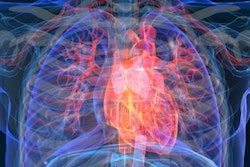
Identifying fibrotic lung disease on CT before transcathetor aortic valve replacement (TAVR) in elderly patients can help predict the procedure's outcome, according to a study published online April 30 in Radiology: Cardiothoracic Imaging.
The findings suggest a way for physicians to better assess their elderly patients before TAVR, wrote a team led by Dr. Cheng Ting Lin of Johns Hopkins University in Baltimore.
"[Our] results highlight the importance of careful imaging review, as it may help guide clinical decision-making and manage the expectations of patients undergoing TAVR," the group wrote.
Aortic stenosis is a major cause of morbidity and mortality in the elderly, Lin's group noted. If untreated, it has a poor prognosis, especially in patients with comorbidities. TAVR is becoming the gold standard for treating the disease, as it is less invasive than surgical valve replacement.
But elderly patients may still have poor outcomes after TAVR due to preexisting lung disease, ranging from hospital readmission to death. CT can help identify chronic lung disease before the TAVR procedure, allowing clinicians to more accurately assess their patients' risk
"The objective of our study was to evaluate whether the identification of parenchymal abnormalities, namely fibrosis and emphysema, in the lungs of patients undergoing TAVR is predictive of adverse outcomes," the group wrote.
To do this, the group conducted a study that included pre-TAVR CT scans from 373 patients taken between 2012 and 2017. Median patient age was 84 years, and median follow-up was 333 days. Using a five-point scale (0 equaled no disease, while 4 equaled 76% to 100% lung involvement), the researchers scored the presence of the following conditions: emphysema, reticulation, and honeycombing; fibrosis was scored as the sum of reticulation and honeycombing scores. The two main outcomes Lin's team investigated were death or a combination of hospital readmission and death.
Of the total patient cohort, 74.9% had chronic lung disease (of these, 15.5% had severe disease), 17.7% had fibrosis, 25.5% had emphysema, and 6.4% had both fibrosis and emphysema.
The group found that fibrosis was independently associated with the combined outcome of readmission and death at one year after TAVR. Additionally, in patients without known chronic lung disease, evidence of fibrosis on pre-TAVR CT was a strong predictor of poor outcome at one year.
| Adverse results at one year after TAVR | |
| Presence or absence of pulmonary fibrosis | Readmission or death |
| No fibrosis at CT | 43.6% |
| No fibrosis at CT (patients without known chronic lung disease) | 26.9% |
| Any fibrosis at CT | 62.6% |
| Any fibrosis at CT (patients without known chronic lung disease) | 67.5% |
The study results may help clinicians better care for and prepare their patients for the TAVR procedure, according to the researchers.
"This information may be helpful for counseling patients before the decision to undergo the TAVR procedure," the group concluded. "Additional prospective studies are needed to assess the prognostic value of abnormal CT findings and whether affected patients would benefit from closer follow-up."



















